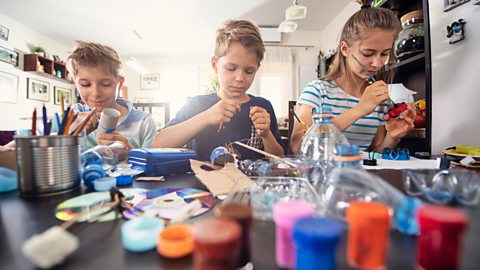It's the classic family holiday destination - the seaside. Buckets and spades, ice cream, sandcastles… or, as a parent, perhaps a chance for a sunny snooze to the sound of lapping waves.
Explorer and TV presenter Dan O'Neill shows us around one of his favourite places - the seaside!
These activities, created in partnership with the RNLI, are perfect for keeping your kids busy adventuring at the beach, so you can have a peaceful moment, but are just as fun when the whole family get involved. There are also some top safety tips to help your child stay safe in and out of the water.

Beach scavenger hunt
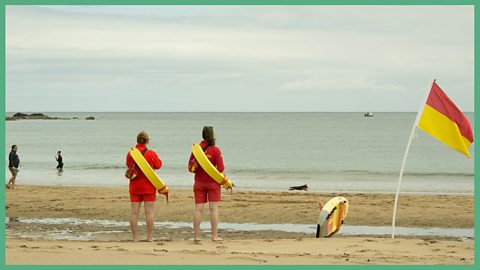
There are lifeguarded beaches all over the UK, which are great spots for family paddling trips. Visit a beach this summer and send your kids on an adventure to collect or spot as many of these objects as possible.
They can start by finding a lifeguard (wearing yellow and red, they should be easy to spot!) and then look for the red and yellow flags - these show the safest areas of the beach to swim and bodyboard.
A spiral seashell
Seaweed
Driftwood
A feather
A blue stone
An ice cream van (time for a snack!)
Remember to help your child wash and sanitise their hands after touching anything they find on the beach.

Fossil hunting
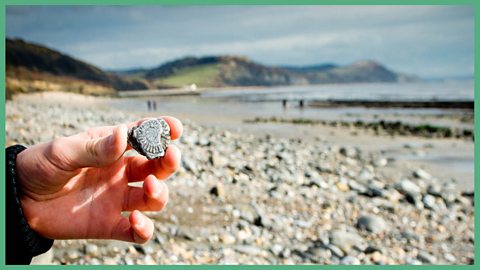
Many beaches around the UK have hidden treasures to discover, so why not encourage your child to give fossil hunting a go? Foraging for fossils may be the closest your little one gets to walking in the footsteps of dinosaurs!
Some locations for fossil hunting can be dangerous - before visiting make sure you research potential dangers and precautions. Be aware of edges around the sea and waterside, as slips and falls can happen in all locations.
They don’t need much in the way of a fossil kit - just a bag for the fossils they find. People always think it’s about hammering but it’s not – it’s about having a keen eye!
Finders keepers! Everyone is welcome to take home loose fossils found on the beach or else they’ll just get washed away. If your child find a fossil that is still embedded in a rock, you must get permission to extract it so that it can be scientifically recorded.
Fossils to look out for…
Belemnites - These were squid-like creatures that had a hard skeleton called a guard. It’s this bullet-shaped guard that is commonly found as a fossil.
Ammonites - The spiral shells of ammonites are commonly found as fossils. Ammonites were related to squid and octopi.
Ichthyosaur teeth and bones – These were marine reptiles with strong jaws and sharp teeth, that looked like a cross between a dolphin and a crocodile. Although finding a complete skeleton isn’t so common, it is possible for your child to find their fossilised teeth and bones in the right spots!

Sand art
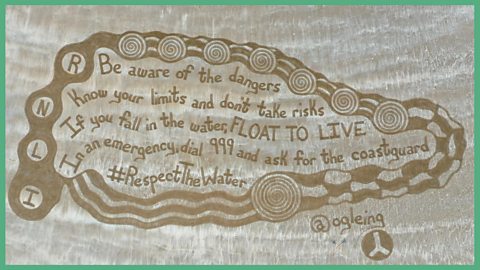 Image source, Rob Ogle
Image source, Rob OgleIf you’re looking for creative beach activities for your child, then treat them to an afternoon of beach art. Whether you’re on a sandy beach or a pebbly cove, you can create amazing pictures and patterns with seaside treasures.
Using whatever they can find, from seaweed to seashells, let your child showcase their artistic talent using the beach as a wide-open canvas. Sticks are great for drawing letters and words, while seashells and rocks will make their artwork come to life.
Using their natural beach finds and sand, why not try some fun beach games? Hopscotch, noughts and crosses and hangman are all easy sand games to play!

Meeting beach wildlife
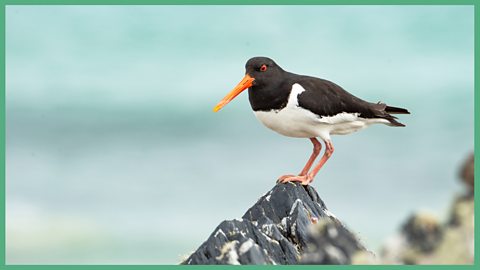
There's a whole variety of creatures for your child to discover that only found on the UK coasts - from elegant birds, to shelled molluscs, to mysterious sea creatures.
With a bit of research into the wildlife around the beach you're visiting, you could create a simple bingo card for your child to tick off everything they see on their adventures. Here are some examples of the kind of animals your child might find on the beach, in rockpools and even in the shallower waters…
Seagulls
Crabs
Limpets
Anemones
Rockpool Fish (a.k.a. Blennies)
Seals
Starfish
Oystercatchers

Does it float?
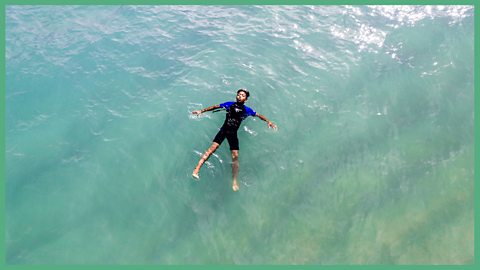
To help your child understand the sort of things that float in water, they can conduct an experiment.
Tell them to find five different items at the beach - they could use items that they found on their scavenger hunt - then fill a bucket with water and put the objects in the bucket one at a time to see what floats and what sinks.
Once they've seen what beach objects float, you can head to the sea together and learn to float yourselves. In an emergency, knowing how to float saves lives. Here's some tips…
Ensure your child is within arm’s reach of someone who is a confident swimmer for supervision
Find a very shallow part of the sea, between the red and yellow flags
Help your child lean back into the water with their ears submerged
Tell them to take a deep breath to help with their buoyancy
They should keep their shoulders down and lift their feet up, while extending their arms to the side, like a giant star fish
To continue floating, all they have to do is make small movements with their hands in the water
Let them know that it's okay if their legs sink relax and bend!

Beach safety tips
Know the flags
Red and yellow beach flag - This shows the lifeguarded area and is the safest place to swim and bodyboard.
Black and white chequered beach flag - For surfboards, stand-up paddleboards, kayaks and other non-powered craft. Launch and recovery area for kitesurfers and windsurfers. Never swim or bodyboard here.
Red beach flag - Danger! Never go into the water under any circumstances when the red flag is flying.
Orange windsock - Indicates offshore or strong wind conditions. Never use inflatables when the windsock is flying.
Check the tide times
It’s really important to be aware of the tide times and other dangers associated with the sea. The UK and Ireland have some of the biggest tidal ranges in the world.
To avoid getting cut off by the tide…
Before you head out, make sure it's safe. Check the tide tables.
While you're out, be aware of your surroundings and the tide's direction.
A beach can seem like a vast playground, but the tide can come in surprisingly quickly!
Stay together!
It's important to teach your child the importance of staying close to an adult, when exploring a beach, and agree on a meeting point in case a family member gets lost.
When playing in the sea this is really important! Make sure your child stays within arm's reach at all times. The sea is not like what you may be used to in a pool, the water is always moving and can be much colder.
It’s important to carry a means of calling and keeping it on you at all times. In an emergency, call 999 or 112 and ask for the Coastguard.
Wear SPF sunscreen and stay hydrated
Make sure everyone has plenty of sunscreen on. If you’re spending the whole day on the sand, you’ll also want to top up your protection regularly throughout the day, so make sure you have enough!
Find some shade. Your bodies will need a break from the sun. Covering your child with hats and clothes will help protect their skin, but to really cool off, find a spot in some shade.
Stay hydrated. Make sure everyone drinks plenty of water throughout the day. Keeping hydrated will help prevent a number of issues that can turn your fun in the sun into a damp squib.
Be aware of Cold Water Shock
It might be difficult to imagine having real problems with the cold during a summer holiday, even in the UK!
However, anything below 15°C is defined as cold water and can seriously affect breathing and movement, so the risk is significant most of the year. Average UK and Ireland sea temperatures are just 12°C!
If you’re planning on enjoying the water with your family, minimise the risk by…
Checking conditions - including water temperature - online before heading to the coast.
Wearing a wetsuit of appropriate thickness for the amount of time you plan to spend in the water and the type of activity you're doing, if entering.
Acclimatise, it’s very important to enter the water slowly and allow time for you or your child's body to get used to the cold. Never jump or dive straight in, as this could cause cold water shock. To help acclimatising, splash the cold water on the neck and face.

The RNLI saves lives at sea. Its volunteers provide a 24-hour search and rescue service around the United Kingdom and Republic of Ireland coasts. They operate over 238 lifeboat stations in the UK and Ireland and more than 240 lifeguard units on beaches around the UK and Channel Islands.

This article was published in July 2022
More from BBC Bitesize Parents' Toolkit…
Parents' Toolkit
Fun activities, real-life stories, wellbeing support and loads of helpful advice - we're here for you and your child.

The L.A.B Scotland: Water safety advice
TD1 Youth Hub have been finding out all about water safety, including what children should do if you get into trouble.
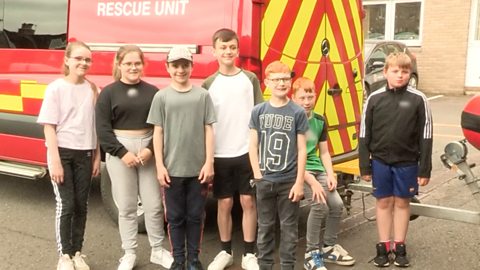
Parents' Toolkit: Help your child's learning. collection
We've got loads of tips and advice for parents to help their children with school and learning.

Five ways to make bird watching a fun family activity
The joy of watching birds is that almost anyone can do it with the minimum of effort. Find out how your family can get involved with this Bitesize article.
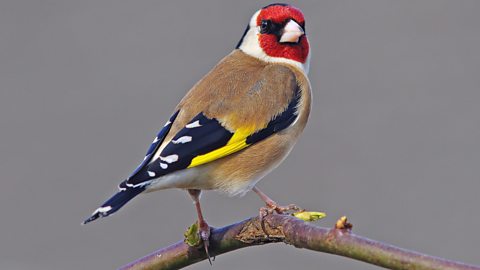
Seven ways to get your kids outdoors
Getting your teens out of the house and into nature can boost their health and wellbeing. Tips on how to do it from parents who are outdoors enthusiasts.
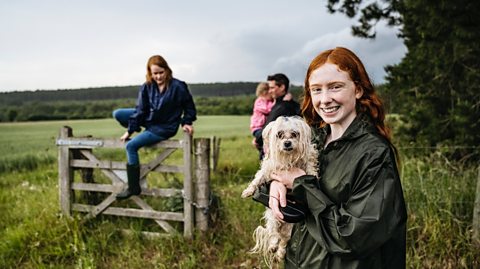
Up-cycling at home: ideas to get crafty with your kids
Crafty ideas for turning everyday objects, destined for the recycling bin, into fun activities for kids at home.
